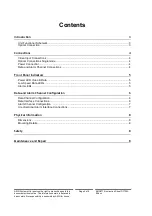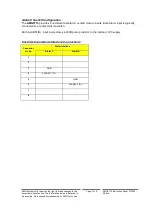
AMG Systems Ltd. reserves the right to make changes to this
document without notice. The information herein is believed to
be accurate. No responsibility is assumed by AMG for its use.
Page 6 of 8
AMG5715 Instruction Sheet D17053-
05.doc
Data and Alarm Channel Configuration
The
AMG5715
transmit unit sends and receives data to/from an
AMG5716
or rackmount equivalent
AMG5716R
receive unit. The physical data interface RS-485, RS-422 or RS-232 is selectable by the
user with the slide switch on the front panel.
There are also two uni-directional alarm channels provided which send on/off signals from the
AMG5715
to the receive unit and are typically used to transmit contact closure status.
Data Channel Configuration
The low speed data channel provides an RS-232, RS-422 (full duplex, four wire) or RS-485 (half
duplex, two wire) interface defined by the mode switch on the front panel. The data channel as
shipped from the factory is set up for RS-485 operation unless otherwise requested.
The data input for both the RS-485 and the RS-422 modes detects a tri-state input condition by
monitoring the differential voltage level across the input. A differential level below 600mV positive or
negative will be detected as a tri-state condition. A level above 600mV positive or negative will be
detected as a logic 1 or logic zero respectively. It is important therefore to terminate the RS-485 bus or
the RS-422 input bus using 120
Ω
if a pre-bias is present on the RS-485 or RS-422 bus.
A large number of third party equipment manufacturers apply a pre-bias on their RS-485 bus. This pre-
bias is applied by pulling one arm of the RS-485 bus high (+5 volts) and the other arm low (0 volts)
using high value resistors within the third party equipment. In order to ensure that the AMG equipment
detects a tri-state condition, then these resistors should have a value above 5k
Ω
. If the third party
bias resistors are less than 750
Ω
the bus can be multiple terminated as required to ensure that a tri-
state level is detected.
The system detects a tri-state input condition on the data channel bus when in RS-485 or RS-422
mode.
Data Interface Connections
Data Channel
Connector
Pin No.
RS-485
[switch right]
RS-422
[switch mid]
RS-232
[switch left]
1
IN + (A)
IN
2
IN - (B)
3
GND
GND
GND
4
5
6
7
IN/OUT + (A)
OUT + (A)
8
IN/OUT - (B)
OUT - (B)
OUT
Note: (A) or (B) in brackets in the above table refers to RS-485 / RS-422 data specification.


























